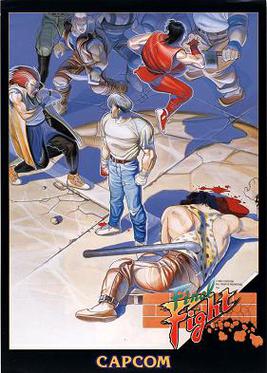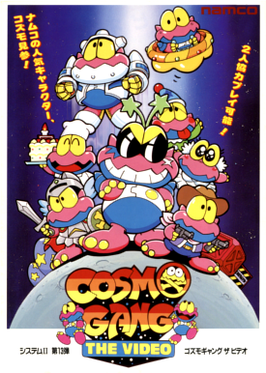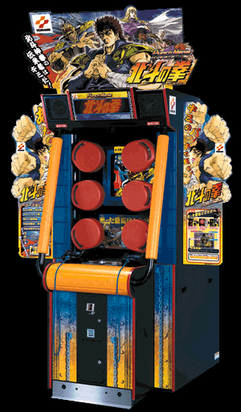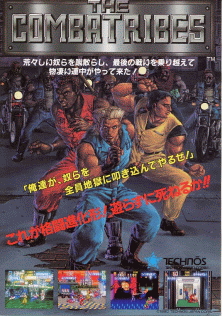
Puzzle Bobble, internationally known as Bust-a-Move, is a 1994 tile-matching puzzle arcade game developed and published by Taito. It is based on the 1986 arcade game Bubble Bobble, featuring characters and themes from that game. Its characteristically cute Japanese animation and music, along with its play mechanics and level designs, made it successful as an arcade title and spawned several sequels and ports to home gaming systems.

Final Fight is a side-scrolling beat-'em-up video game produced by Capcom. Originally released as an arcade game in 1989, it was the seventh title released for the CP System hardware. Set in the fictional Metro City, the game lets the player control one of three street fighters: former pro wrestler and city mayor Mike Haggar, expert brawler Cody Travers, and modern-day ninja Guy. The trio set out to rescue Jessica when she is kidnapped by the Mad Gear Gang.

Shinobi (忍) is a side-scrolling hack and slash video game produced by Sega, originally released for arcades on the Sega System 16 board in 1987. The player controls ninja Joe Musashi, to stop the Zeed terrorist organization from kidnapping students of his clan.

Double Dragon II: The Revenge is a side-scrolling beat 'em up produced by Technōs Japan originally released as a coin-operated arcade game in 1988. It is the first sequel to Double Dragon, released during the previous year. The sequel involves Billy and Jimmy Lee in a mission to avenge Billy's girlfriend Marian after she is shot to death by the Black Warriors leader Willy, who is retaliating against the Lee brothers after his defeat at the end of the previous game. Double Dragon II was initially developed as an upgrade kit for the original Double Dragon, but evolved into a stand-alone game due to an increase in memory size, resulting in the developers reusing assets for both games.

Nekketsu Kōha Kunio-kun, released as Renegade in the West, is a beat 'em up video game developed by Technōs Japan and distributed by Taito for the arcades in 1986. In the original Japanese version Nekketsu Kōha Kunio-kun, the game revolves around a high-school delinquent named Kunio-kun who must stand up against a series of rival gangs frequently targeting his classmate Hiroshi. In the Western version Renegade, the player controls a street brawler who must face four different gangs in order to rescue his girlfriend being held captive by a mob boss.

Operation Thunderbolt is a light gun shooter video game developed by Taito and released for arcades in 1988. As the sequel to Operation Wolf, changes include two-player gameplay with two positional gun controllers mounted on the arcade cabinet, and a new forward-scrolling pseudo-3D perspective combined with side-scrolling sections.

Teenage Mutant Ninja Turtles: Turtles in Time, released as Teenage Mutant Hero Turtles: Turtles in Time in Europe, is a beat 'em up arcade video game produced by Konami and released in 1991. A sequel to the original Teenage Mutant Ninja Turtles arcade game, it is a scrolling beat 'em up type game based mainly on the 1987 TMNT animated series. Originally an arcade game, Turtles in Time was ported to the Super Nintendo Entertainment System in 1992 under the title Teenage Mutant Ninja Turtles IV: Turtles in Time, continuing the numbering from the earlier Turtles games released on the original NES. That same year, a game that borrowed many elements, Teenage Mutant Ninja Turtles: The Hyperstone Heist, was released for the Sega Genesis.

The Legend of Kage is a side-scrolling hack-and-slash game developed and released by Taito as an arcade video game in 1985. It was ported to the Amstrad CPC, Commodore 64, Nintendo Entertainment System, MSX, Sharp X1, and ZX Spectrum.

Kiki Kaikai is a shoot 'em up video game developed and published by Taito for arcades in 1986. Set in Feudal Japan, the player assumes the role of a Shinto shrine maiden who must use her o-fuda scrolls and gohei wand to defeat renegade spirits and monsters from Japanese mythology. The game is noteworthy for using a traditional fantasy setting in a genre otherwise filled with science fiction motifs.

Double Dragon is a 1987 beat 'em up video game developed by Technōs Japan and distributed by Taito for arcades across Asia, North America and Europe. It is the first title in the Double Dragon franchise. The game's development was led by Yoshihisa Kishimoto, and it is a spiritual and technological successor to Technos' earlier beat 'em up, Nekketsu Kōha Kunio-kun (1986), released outside of Japan by Taito as Renegade; Kishimoto originally envisioned it as a direct sequel and part of the Kunio-kun series, before making it a new game with a different cast and setting.

Cosmo Gang the Video is a 1992 fixed shooter arcade game developed and published by Namco. A home conversion for the Super Famicom was released the same year. Controlling the Hyper Beat starship, the player is tasked with ridding the galaxy of the Cosmo Gang, a race of aliens that cause mischief across Earth. Gameplay involves shooting enemies and avoiding projectiles. Power-up items can be collected to grant the player additional abilities. It ran on the Namco System 2 arcade board.

Fighting Mania: Fist of the North Star, released in Japan as Punch Mania: Hokuto no Ken, is a boxing game based on the manga series Fist of the North Star released by Konami in 2000 as a coin-operated arcade game.

The Combatribes is a 1990 beat 'em-up game released for the arcades by Technos Japan Corp. A home version for the Super Nintendo Entertainment System was also released in 1992. The game centers on three vigilantes who must fight against numerous street gangs in futuristic New York City. The SNES version was released for the Wii Virtual Console in North America on November 30, 2009.

Undercover Cops (アンダーカバーコップス) is an arcade-style beat 'em up video game developed and published by Irem, originally for the arcades in 1992. It is Irem's first attempt in the modern beat 'em up genre that was founded by Data East’s Kung-Fu Master. Players control "city sweepers", a police agent-like group who fight crime by taking down thugs in New York City in the year 2043.
Darius is a shoot 'em up video game franchise developed and published by Taito. The eponymous first game was released in February 1987 for arcades, and has since been followed by six sequels and several spin-offs. The series takes place during the events of a war between humans and the Belsar empire, which plot to destroy all that is left of mankind. Darius is known for its branching stage paths, upbeat soundtrack, and cute sea life-inspired enemies.

Superman is a 1988 arcade action game released by Taito and featuring the DC Comics character Superman. While not directly based on the original film series, throughout much of the game the "Superman Main Theme" and "Can You Read My Mind" from the Superman films are used as background music.

Crime Fighters (クライムファイターズ) is a 1989 side-scrolling beat-em-up released by Konami for the arcades. The players takes control of a duo of undercover police officers who are assigned to rescue a group of kidnapped damsels from a crime boss and his army of punks.

Growl, known in Japan as Runark, is a belt-scrolling beat-'em-up originally released for the arcades by Taito in 1990. Set in the early 20th century, the player controls a forest ranger who must protect the local wildlife from a group of evil poachers who are driving the animals to extinction. A home version was released for the Sega Genesis in November 1991. It was also included in the arcade game compilation Taito Legends 2 for the PlayStation 2, Xbox and Microsoft Windows.

The Ninja Warriors is a beat 'em up video game developed by Natsume for the Super Nintendo Entertainment System and published by Taito in Japan and North America in 1994 and by Titus in Europe in 1995. It is a follow-up to Taito's 1987 arcade game of the same title, and shares similar gameplay. The player can choose between playing as one of three ninja androids, each with different attributes and a unique set of moves including jumps, dashes, throws, and other attacks. The game was developed by the same team at Natsume that later developed Wild Guns (1994).

Captain Commando is a 1991 futuristic side-scrolling beat 'em up originally developed and published by Capcom as an arcade video game, and later ported to several other platforms. It was the seventeenth game produced for the company's CP System hardware. The game stars the titular superhero who was originally conceived as a fictional spokesman used by Capcom USA in the company's console games during the late 1980s. On September 13, 2018, Capcom announced Capcom Beat 'Em Up Bundle with Captain Commando being one of seven titles and released digitally for Nintendo Switch, PlayStation 4, Xbox One, and Windows on September 18, 2018.


















